Read and download free pdf of CBSE Class 9 Mathematics Constructions Worksheet Set B. Students and teachers of Class 9 Mathematics can get free printable Worksheets for Class 9 Mathematics Chapter 11 Constructions in PDF format prepared as per the latest syllabus and examination pattern in your schools. Class 9 students should practice questions and answers given here for Mathematics in Class 9 which will help them to improve your knowledge of all important chapters and its topics. Students should also download free pdf of Class 9 Mathematics Worksheets prepared by teachers as per the latest Mathematics books and syllabus issued this academic year and solve important problems with solutions on daily basis to get more score in school exams and tests
Worksheet for Class 9 Mathematics Chapter 11 Constructions
Class 9 Mathematics students should download to the following Chapter 11 Constructions Class 9 worksheet in PDF. This test paper with questions and answers for Class 9 will be very useful for exams and help you to score good marks
Class 9 Mathematics Worksheet for Chapter 11 Constructions
Very Short Answer Type Questions:
Question: Can a ΔXYZ be constructed, in which XY = 5 cm, ∠X = 50° and YZ + XZ = 5 cm?
Answer: No, ΔXYZ can’t be constructed.
Since, sum of two sides of triangle must be greater than third side, but here, XY = YZ + XZ.
Question: If we bisect a line segment AB, then each of the equal part we get measures 3.8 cm. Find the length of AB.
Answer: If we bisect line segment AB, then we get each part equal to 3.8 cm.
∴ Length of AB = 2 × 3.8 cm = 7.6 cm
Question: If we draw a perpendicular bisector of a line segment AB = 9 cm which bisects AB at M, then find AM and BM.
Answer: 1. Since, perpendicular bisector of a line segment divides it into two equal parts.
∴ AM = BM = 9/2 cm = 4.5 cm
Question: Draw a straight angle. Using compass bisect it. Name the angles obtained.
Answer:

Steps of construction :
Step I : Draw any straight angle (say ∠AOC)
Step II : Draw OB , the bisector of ∠AOC.
Then, ∠AOB and ∠BOC are the required angles obtained by bisecting straight ∠AOC.
Short Answer Type Questions:
Question: Construct ΔABC such that AB = 5.8 cm, BC + CA = 7 cm and ∠B = 60°.
Answer: Steps of Construction :

Step I : Draw a line segment AB = 5.8 cm and ∠ABX = 60°.
Step II : Cut line segment BD = 7 cm along BX .
Step III : Join AD and draw PQ, perpendicular bisector of AD.
Step IV : Let PQ intersects BD at C.
Step V : Join AC.
Hence, ΔABC is the required triangle.
Question: Draw a line segment AB = 13.2 cm. Divide it into 4 equal parts using ruler and compass. Also, measure the length of each part.
Answer: Steps of construction :

Step I : Draw a line segment AB = 13.2 cm.
Step II : Draw a perpendicular bisector of AB, which intersect AB at M.
Step III : Again, draw a perpendicular bisector of AM; which intersects AM at P.
Step IV : Also, draw a perpendicular bisector of BM, which intersects BM at Q.
Thus, AB is divided into four equal parts, where
AP = PM = MQ = QB
= 1/4 AB = 13.2/4 = 3.3 cm
Question: Draw a line segment of length 6 cm. Draw perpendicular bisector of this line segment.
Answer: Steps of construction :
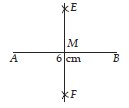
Step I : Draw a line segment AB = 6 cm by using a ruler.
Step II : With A as centre and radius more than half of AB, draw arcs on both sides of AB.
Step III : With B as centre and the same radius (as taken in previous step), draw arcs cutting the
previous arcs drawn in Step II at E and F respectively.
Step IV : Join EF intersecting AB at M.
Thus, EF is perpendicular bisector of the line segment AB.
Question: Draw line segment AB = 8.8 cm and draw its perpendicular bisector and measure the length of each part.
Answer: Steps of construction :
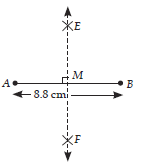
Step I : Draw a line segment AB = 8.8 cm by using graduated ruler.
Step II : Taking A as centre and radius equal to more than half of AB, draw arcs on both sides of line segment AB.
Step III : Taking B as centre and same radius as in Step II, draw arcs on both sides of AB cutting the previous arcs at E and F.
Step IV : Join EF intersecting AB at M. Then, EF is the required perpendicular bisector of AB. On measuring by graduated ruler, we find that
AM = MB = 4.4 cm.
Question: Construct ΔABC such that BC = 6 cm, ∠B = 45° and AB – AC = 3 cm.
Answer: Steps of Construction :
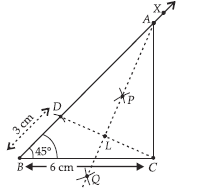
Step I : Draw BC = 6 cm and ∠CBX = 45°.
Step II : On BX, cut BD = 3 cm.
Step III : Join CD.
Step IV : Draw PQ, perpendicular bisector of CD.
Step V : PQ intersects BX at A and CD at L.
Step VI : Join AC.
Hence, ΔABC is the required triangle.
Question: Using ruler and compass only, draw an angle of measure 135°.
Answer: Steps of construction :
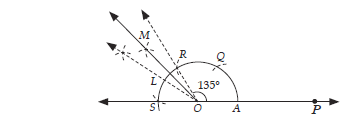
Step I : Draw a ray OP.
Step II : With centre O and a suitable radius, draw an arc which cuts OP at A.
Step III : With the same radius and starting from A, mark points Q, R and S on the arc drawn in Step II such that AQ = QR = RS
Step IV : Draw OL, the bisector of ROS.
Step V : Draw OM , the bisector of ROL.
Thus, ∠POM = ∠POR + ∠ROM = 120° + 15° = 135°
Question: Construct an equilateral triangle, the sum of its two sides is 8 cm.
Answer: We know that, in equilateral triangle, all the angles are of equal measure and all sides are of equal length.
Since, sum of two-sides of triangle is 8 cm, therefore each side of equilateral triangle will be 4 cm.
Steps of construction :
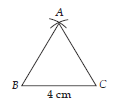
Step I : Draw the line segment BC = 4 cm.
Step II : Taking B as centre and radius
= 4 cm draw an arc.
Step III : Taking C as centre and same radius as in Step II, draw an arc cutting the previous arc at A.
Step IV : Join AB and AC.
Then, ABC is the required equilateral triangle.
Question: Construct a square of side 3 cm.
Answer: Steps of construction :
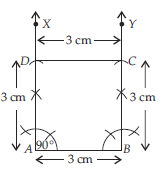
Step I : Draw a line segment AB = 3 cm.
Step II : Draw angle of 90° at points A and B of the line segment AB. Also draw AX parallel to BY.
Step III : Cut AD and BC of length 3 cm on AX and BY respectively.
Step IV : Join CD.
Then, ABCD is the required square of side 3 cm.
Question: Using ruler and compass only, draw a right angle.
Answer: Steps of construction :
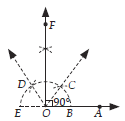
Step I : Draw a ray OA .
Step II : Taking O as centre and suitable radius, draw a semicircle, which cuts OA at B.
Step III : With B as centre and the same radius, as in Step II, draw an arc cutting the semicircle at C. Again, with C ascentre, draw an arc cutting the semicircle at D.
Step IV : Draw OC and OD .
Step V : Draw OF , the bisector of ∠COD.
Thus, ∠AOF = 90°
Long Answer Type Questions:
Question: Construct a ΔABC in which BC = 5.6 cm, AC – AB = 1.6 cm and ∠B = 45°. Justify your construction.
Answer: Steps of construction :
Step I : Draw BC = 5.6 cm.
Step II : At B, construct ∠CBX = 45°.
Step III : Produce XB to X′ to form line XBX.
Step IV : Along ray BX′, cut-off a line segment BD = 1.6 cm.
Step V : Join CD.
Step VI : Draw perpendicular bisector of CD which cuts BX at A.
Step VII : Join CA to obtain required triangle BAC.
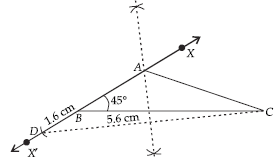
Justification:
Since A lies on the perpendicular bisector of CD.
∴ AC = AD = AB + DB = AB + 1.6 ⇒ AC – AB = 1.6 cm which justified the construction.
Question: Give reason:
(i) Construction of an angle of 22.5° is possible with the help of ruler and compass.
(ii) It is not possible to construct a ΔABC given that BC = 7 cm, ∠B = 45° and AB – AC = 10 cm.
(iii) We can construct an angle of 67.5° using ruler and compass.
(iv) Construction of ΔDEF, if EF = 5.5 cm, ∠E = 75° and DE – DF = 3 cm is possible.
Answer: (i) Yes, because 22.5° = 45° ÷ 2 and 45° can be constructed.
(ii) Yes, it is not possible to construct a ΔABC in which BC = 7 cm and AB – AC = 10 cm with ∠B = 45° because the difference between the given two sides is not less than the third side.
(iii) Yes, we can construct an angle of 67.5°, because 67.5° = 135° ÷ 2 and 135° = 90° + 45°, which can be constructed.
(iv) Yes, it is possible to construct a ΔDEF in which EF = 5.5 cm, ∠E = 75° and DE – DF = 3 cm because the difference between the given two sides is less than the third side.
| CBSE Class 9 Mathematics Coordinate Geometry Worksheet |
| CBSE Class 9 Mathematics Euclids Geometry Worksheet Set A |
| CBSE Class 9 Mathematics Euclids Geometry Worksheet Set B |
| CBSE Class 9 Mathematics Circles Worksheet Set A |
| CBSE Class 9 Mathematics Circles Worksheet Set B |
| CBSE Class 9 Mathematics Circles Worksheet Set C |
| CBSE Class 9 Mathematics Area Of Triangles Herons Formula Worksheet Set A |
| CBSE Class 9 Mathematics Statistics Worksheet Set A |
| CBSE Class 9 Mathematics Statistics Worksheet Set B |
Worksheet for CBSE Mathematics Class 9 Chapter 11 Constructions
We hope students liked the above worksheet for Chapter 11 Constructions designed as per the latest syllabus for Class 9 Mathematics released by CBSE. Students of Class 9 should download in Pdf format and practice the questions and solutions given in the above worksheet for Class 9 Mathematics on a daily basis. All the latest worksheets with answers have been developed for Mathematics by referring to the most important and regularly asked topics that the students should learn and practice to get better scores in their class tests and examinations. Expert teachers of studiestoday have referred to the NCERT book for Class 9 Mathematics to develop the Mathematics Class 9 worksheet. After solving the questions given in the worksheet which have been developed as per the latest course books also refer to the NCERT solutions for Class 9 Mathematics designed by our teachers. We have also provided a lot of MCQ questions for Class 9 Mathematics in the worksheet so that you can solve questions relating to all topics given in each chapter.
You can download the CBSE Printable worksheets for Class 9 Mathematics Chapter 11 Constructions for latest session from StudiesToday.com
There is no charge for the Printable worksheets for Class 9 CBSE Mathematics Chapter 11 Constructions you can download everything free
Yes, studiestoday.com provides all latest NCERT Chapter 11 Constructions Class 9 Mathematics test sheets with answers based on the latest books for the current academic session
CBSE Class 9 Mathematics Chapter 11 Constructions worksheets cover all topics as per the latest syllabus for current academic year.
Regular practice with Class 9 Mathematics worksheets can help you understand all concepts better, you can identify weak areas, and improve your speed and accuracy.

